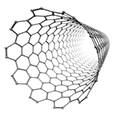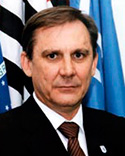
Wren 2018
The Workshop on Renewable Energy Sources and Nanotechnology
Laboratory for Preparation and Computation of Nanomaterials (LPCN)
SEMINARS
Wren 2018

SEMINAR 15:
PROSPECTIVE INVESTIGATIONS OF TUNGSTEN AND MOLYBDENUM CARBIDE-CONTAINING MATERIALS AS CATALYSTS FOR ELECTROCHEMICAL ENERGY CONVERSION PROCESSES: PROTON, OXYGEN, AND CO/CO2 REDUCTION REACTIONS.
SPEAKER: Edson A. Ticianelli
Abstract: In the last decade, transition metal carbides, particularly based of molybdenum and tungsten, have emerged as novel materials with promising catalytic properties toward several important practical electrochemical reactions. In this presentation, the activity of such materials will be discussed for the following electrochemical approaches/reactions: i) the electrocatalysis of oxygen reduction reaction (ORR) in acid media on Pt- and Pt2Ni-nanoparticles supported on carbon forming composites with tungsten and molybdenum carbides with cubic and hexagonal structures; ii) the hydrogen evolution reaction (HER) in acid and alkaline media on TM-modified molybdenum carbide (TM-Mo2C) catalysts, where TM is a transition metal, such as, Fe, Co, Ni and Cu; iii) the CO2 and CO electro-reduction reactions in 0.1 M NaClO4 and 0.5 and 1 M KHCO3 solutions on carbon supported tungsten and molybdenum carbides. Syntheses of the carbide-based catalysts have been conducted employing different procedures, after which the produced material are characterized by X-Ray diffraction (XRD), energy dispersive X-ray spectroscopy, (EDS), X-ray photoelectron spectroscopy (XPS), in situ X-ray absorption near edge structure (XANES), and transmission electron microscopy (TEM). Cyclic voltammetry and polarization measurements on stationary and rotation disk electrodes have been employed for the electrochemical investigations. For the CO/CO2 reduction, reaction products were analyzed by differential electrochemical mass spectrometry (DEMS) and high performance liquid chromatography (HPLC) analyses.
Enhanced mass and specific ORR activities are seen for Pt–molybdenum carbide-derived composites compared to Pt--WC/C, which in turn presents specific activity for the ORR similar to that of a standard carbon supported Pt catalyst (Pt/C). For Pt--WC1-x/C composites, the specific activity is also higher than that of Pt/C when a carbide-to carbon load of 40 wt.% is used. In the case of the HER, high activities are observed for all TM-Mo2C catalysts in acid and alkaline media. Nonetheless, while in acid there is a decrease in the activity upon metal doping, with an activity trend of -Mo2C > Fe-Mo2C > Co-Mo2C > Ni Mo2C > Cu-Mo2C, the opposite tendency is found in alkaline solutions. In situ near-edge X-ray adsorption analysis reveals different oxidation states of the TM inside the carbide in both solutions. In acid, a positive charge of the TM in the materials in the electrochemical environment is possibly at the origin of the deleterious effect of Fe, Co, Ni and Cu. In addition, catalysts stability against dissolution in acid media is increased by doping of molybdenum carbide with TM. Regarding of CO and CO2 electro-reductions in 0.1 M NaClO4 and 0.5 and 1 M KHCO3 solutions, results suggest that neither molybdenum nor tungsten carbides can be considered as active catalysts, in contrast to reported results in gas phase. It appears that both the aqueous environment and their activity toward the HER surpass the reactivity toward these latter reactions. Acknowledgements: Fundação de Amparo à Pesquisa do Estado de São Paulo (FAPESP - Procs. 2013/16930-7 and 2014/23486-9) and Coordenação de Aperfeiçoamento de Pessoal de Nível Superior (CAPES) (Procs. 1423454), Brazil, for financial supports.
SEMINAR 16:
SILVER COMPLEX OXIDES AS PHOTOACTIVE MATERIALS FOR SOLAR FUELS PRODUCTION AND ENVIRONMENTAL REMEDIATION.
SPEAKER: Miguel T. Galante
Abstract: The search for stable, low cost, efficient photoactive materials is an important task in the field of solar energy conversion. [1,2] While TiO2 has been extensively studied for water remediation due to its stability and relative low cost, its wide band gap is still a major drawback, since less than 10% of solar spectrum is absorbed. On the other hand, Cu(I) oxide, while being a low cost, highly active material with a broad light absorption hand, is extremely unstable under light irradiation. As a promising alternative, complex oxides are versatile compounds that can be tuned in terms of electronic structure and light absorption properties.[2] In this presentation, it is shown how the combination of silver with different elements to form ternary oxides can provide interesting properties such as higher stability and charge carrier mobility. The main structural and electronic features related to photoelectrochemical properties are presented, together with experimental data from our group and from the literature. By combining silver (I) oxide with different metal oxides (e.g. V2O5, Bi2WO6, WO3), band gap narrowing is attained due to valence band upshift. Ternary oxides with both n- and p-type behavior can be obtained, providing a broad range of applications for silver oxides. As an example of the versatility of such materials, photoelectrochemical properties of quaternary phase AgBiW2O8 will be presented, with some promising results for CO2 reduction and water remediation.

SEMINAR 17:
STUDY OF INDIVIDUAL NANOSYSTEMS BY TRANSMISSION ELECTRON MICROSCOPY EXPERIMENTS.
SPEAKER: Daniel Mario Ugarte
Abstract: Nano-systems attract a great deal of interest as one of the most promising alternatives to continue miniaturization of electronic devices. Although the recent huge progress, the detailed analysis of physical and chemical of individual nanoscale systems represents a serious challenge, rendering difficult the development of basic understanding and technological exploration. The high spatial resolution of electron beam instruments has transformed electron microscopy (EM) into an essential tool of cutting edge research in nanoscience and technology. We will present the application electron microscopy techniques to analyze in detail the physical properties of individual nanosystems. In particular, we will address, the atomistic aspects associated with the measurement of subtle lattice distortions within individual semiconductor nanowires by combining imaging and diffraction approaches

SEMINAR 6:
SOLAR WATER REMEDIATION: REMOVAL OF AMOXICILLIN AND CIPROFLOXACIN ANTIBIOTICS USING SEMICONDUCTOR ELECTRODES AND SOLAR CELLS.
SPEAKER: Fernando Luiz Marcelo Antunes
Abstract: At the end of 2017 the World installed capacity of renewables to produce electricity was 2,179 GW. In Brazil those figures are 17 GW for wind and solar installations. The 482 ANEEL Resolution of 2012 and updated in 2015 is a milestone in the growth of solar energy in distributed generation in Brazil. Within this real scenario of participation of renewables in the Brazilian energy matrix challenges such as development of national technology, availability of technical support for operation and maintenance of installations, intermittence of renewables source and the need for a constant and stable supply, must be overcome for Brazil to become an active agent in large electric power production market from renewable sources. Several countries is pursing to achieve a high grid integration from variable renewable energy (VRE), such as wind and solar photovoltaic (PV) systems, as a major contributor. With the reduction in costs for these technologies, large-scale deployments are happening around the world. Power electronics technology plays an important role in distributed generation and in integration of renewable energy sources into the electrical grid, and it is widely used and rapidly expanding as these of applications become more integrated with grid-based systems.

SEMINAR 18:
SOLID-STATE CHEMISTRY MEETS PHOTOELECTROCHEMISTRY: NEW FAMILIES OF TERNARY OXIDES AND CHALCOGENIDES.
SPEAKER: Krishnan Rajeshwar
Abstract: Even after ca. four decades of R&D effort, we still do not have a "magic bullet" inorganic semiconductor to photoelectrochemically generate fuels or chemicals from sunlight in a sustainable, efficient and environment-friendly manner. While it is unlikely that a single semiconductor candidate will emerge that simultaneously satisfies all the optical, electrical, surface chemical, and electrochemical prerequisites for efficient solar conversion, complex oxides or chalcogenides (or derivatives thereof, e.g., oxynitrides) do provide a versatile framework for rational design of the "perfect beast" in a chemical architectural sense. Ultimately two or more such semiconductor compositions can be combined in a composite design much like complementary functionalities are combined in photosynthetic assemblies in Nature. In such designs, the semiconductor(s) and the photoactive junction can even be separated from the electrolyte and the electrocatalyst component in a "buried junction" design. In this vein, the author's laboratory has been engaged in the development of time- and energy-efficient methods for synthesizing new families of photoelectrode or photocatalyst materials. In this particular talk, the author will provide first a context for the key role that solid-state chemistry paradigms and principles can play in photoelectrode designs for driving multi-electron processes typical of solar fuel generation. Two representative ternary semiconductor systems, namely, Cu-V-O and M-Ln-X (M = divalent metal, e.g., Ba, Ln = lanthanide element, e.g., Ce, and X = chalcogen, e.g., S) will be discussed in this talk.
E-mail:
+55 91 3201-8091








WREN 2018. © All Right Reserved
Laboratory for Preparation and Computation of Nanomaterials (LPCN)-2018.